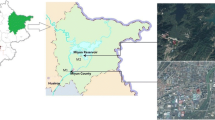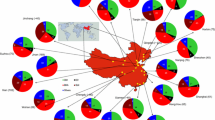Abstract
The pollution characteristics of PM2.5 and correlation analysis with meteorological parameters in Xinxiang during the Shanghai Cooperation Organization Prime Ministers’ Meeting were investigated. During the whole meeting, nine PM2.5 samples were collected at a suburban site of Xinxiang, and the average concentration of PM2.5 was 122.28 μg m−3. NO3 −, NH4 +, SO4 2− accounted for 56.8% of the total water-soluble ions. In addition, with an exception of Cl−, all of water-soluble ions decreased during the meeting. Total concentrations of crustal elements ranged from 6.53 to 185.86 μg m−3, with an average concentration of 52.51 μg m−3, which accounted for 82.5% of total elements. The concentrations of organic carbon and elemental carbon were 7.71 and 1.52 μg m−3, respectively, lower than those before and after the meeting. It is indicated that during the meeting, limiting motor vehicles is to reduce exhaust emissions, delay heating is to reduce the fossil fuel combustion, and other measures are to reduce the concentration of PM2.5. The directly dispersing by mixing layer height increase and the indirectly reducing the formation of secondary aerosol by low relative humidity, and these are the only two key removing mechanisms of PM2.5 in Xinxiang during the meeting.








Similar content being viewed by others
References
Asman, W. A. H., Sutton, M. A., & Schjorring, J. K. (1998). Ammonia: Emission, atmospheric transport and deposition. New Phytologist, 139, 27–48.
Cheng, Z., Wang, S., Jiang, J., Fu, Q., Chen, C., Xu, B., et al. (2013). Long-term trend of haze pollution and impact of particulate matter in the Yangtze river delta, china. Environmental Pollution, 182, 101–110.
Dawson, J. P., Adams, P. J., & Pandis, S. N. (2007). Sensitivity of PM2.5 to climate in the eastern US: A modeling case study. Atmospheric Chemistry and Physics, 7, 4295–4309.
Dimitriou, K., & Kassomenos, P. (2014). Indicators reflecting local and transboundary sources of PM2.5 and PMCOARSE in Rome—impacts in air quality. Atmospheric Environment, 96, 154–162.
Feng, J., Sun, P., Hu, X., Zhao, W., Wu, M., & Fu, J. (2012). The chemical composition and sources of PM2.5 during the 2009 Chinese new year’s holiday in Shanghai. Atmospheric Research, 118, 435–444.
Feng, J., Yu, H., Liu, S., Su, X., Li, Y., Pan, Y., et al. (2016a). PM2.5 levels, chemical composition and health risk assessment in Xinxiang, a serious air pollution city in North China. Environmental Geochemistry and Health. doi:10.1007/s10653-016-9874-5.
Feng, J., Yu, H., Su, X., Liu, S., Li, Y., Pan, Y., et al. (2016b). Chemical composition and source apportionment of PM2.5 during Chinese spring festival at Xinxiang, a heavily polluted city in north china: Fireworks and health risks. Atmospheric Research, 182, 176–188.
Fuentes-Mattei, E., Rivera, E., Gioda, A., Sanchez-Rivera, D., Roman-Velazquez, F. R., & Jimenez-Velez, B. D. (2010). Use of human bronchial epithelial cells (BEAS-2B) to study immunological markers resulting from exposure to PM2.5 organic extract from Puerto Rico. Toxicology and Applied Pharmacology, 243, 381–389.
Gray, H. A., Cass, G. R., Huntzicker, J. J., Heyerdahl, E. K., & Rau, J. A. (1986). Characteristics of atmospheric organic and elemental carbon particle concentrations in Los Angeles. Environmental Science and Technology, 20, 580–589.
Huang, K., Zhuang, G., Lin, Y., Wang, Q., Fu, J. S., Zhang, R., et al. (2012). Impact of anthropogenic emission on air quality over a megacity—revealed from an intensive atmospheric campaign during the Chinese spring festival. Atmospheric Chemistry and Physics, 12, 11631–11645.
Ianniello, A., Spataro, F., Esposito, G., Allegrini, I., Rantica, E., Ancora, M. P., et al. (2010). Occurrence of gas phase ammonia in the area of Beijing (china). Atmospheric Chemistry and Physics, 10, 9487–9503.
Kim, K. W., Kim, Y. J., & Oh, S. J. (2001). Visibility impairment during Yellow Sand periods in the urban atmosphere of Kwangju, Korea. Atmospheric Environment, 35, 5157–5167.
Lee, K.-Y., Wong, C. K.-C., Chuang, K.-J., Bien, M.-Y., Cao, J.-J., Han, Y.-M., et al. (2014). Methionine oxidation in albumin by fine haze particulate matter: An in vitro and in vivo study. Journal of Hazardous Materials, 274, 384–391.
Li, X., Kong, S., Yin, Y., Li, L., Yuan, L., Li, Q., et al. (2016). Polycyclic aromatic hydrocarbons (PAHs) in atmospheric PM2.5 around 2013 Asian youth games period in Nanjing. Atmospheric Research, 174–175, 85–96.
Li, Y., Schwandner, F. M., Sewell, H. J., Zivkovich, A., Tigges, M., Raja, S., et al. (2014). Observations of ammonia, nitric acid, and fine particles in a rural gas production region. Atmospheric Environment, 83, 80–89.
Meng, Z. Y., Lin, W. L., Jiang, X. M., Yan, P., Wang, Y., Zhang, Y. M., et al. (2011). Characteristics of atmospheric ammonia over Beijing, China. Atmospheric Chemistry and Physics, 11, 6139–6151.
Pan, Y., Wang, Y., Sun, Y., Tian, S., & Cheng, M. (2013). Size-resolved aerosol trace elements at a rural mountainous site in northern China: Importance of regional transport. Science of the Total Environment, 461–462, 761–771.
Schwarz, J., Cusack, M., Karban, J., Chalupníčková, E., Havránek, V., Smolík, J., et al. (2016). PM2.5 chemical composition at a rural background site in central Europe, including correlation and air mass back trajectory analysis. Atmospheric Research, 176–177, 108–120.
Sheng, L., Lu, K., Ma, X., Hu, J., Song, Z., Huang, S., et al. (2015). The air quality of Beijing–Tianjin–Hebei regions around the Asia-Pacific economic cooperation (APEC) meetings. Atmospheric Pollution Research, 6, 1066–1072.
Stoeger, T., Reinhard, C., Takenaka, S., Schroeppel, A., Karg, E., Ritter, B., et al. (2005). Instillation of six different ultrafine carbon particles indicates a surface area threshold dose for acute lung inflammation in mice. Environmental Health Perspectives, 114, 328–333.
Sun, Z., Mu, Y., Liu, Y., & Shao, L. (2013). A comparison study on airborne particles during haze days and non-haze days in Beijing. Science of the Total Environment, 456–457, 1–8.
Tai, A. P. K., Mickley, L. J., & Jacob, D. J. (2010). Correlations between fine particulate matter (PM2.5) and meteorological variables in the United States: Implications for the sensitivity of PM2.5 to climate change. Atmospheric Environment, 44, 3976–3984.
Tan, J., Duan, J., Zhen, N., He, K., & Hao, J. (2016). Chemical characteristics and source of size-fractionated atmospheric particle in haze episode in Beijing. Atmospheric Research, 167, 24–33.
Tao, J., Ho, K.-F., Chen, L., Zhu, L., Han, J., & Xu, Z. (2009). Effect of chemical composition of PM2.5 on visibility in Guangzhou, China, 2007 spring. Particuology, 7, 68–75.
Tao, J., Zhang, L., Engling, G., Zhang, R., Yang, Y., Cao, J., et al. (2013). Chemical composition of PM2.5 in an urban environment in Chengdu, china: Importance of springtime dust storms and biomass burning. Atmospheric Research, 122, 270–283.
Wang, Z., Li, Y., Chen, T., Li, L., Liu, B., Zhang, D., et al. (2015). Changes in atmospheric composition during the 2014 APEC conference in Beijing. Journal of Geophysical Research: Atmospheres, 120, 12695–12707.
Wang, J., & Ogawa, S. (2015). Effects of meteorological conditions on PM2.5 concentrations in Nagasaki, Japan. International Journal of Environmental Research and Public Health, 12, 9089–9101.
Wang, Y., Zhuang, G. S., Zhang, X. Y., Huang, K., Xu, C., Tang, A. H., et al. (2006). The ion chemistry, seasonal cycle, and sources of PM2.5 and TSP aerosol in Shanghai. Atmospheric Environment, 40, 2935–2952.
Watson, J. G. (2002). Visibility: Science and regulation. Journal of the Air and Waste Management Association, 52, 628–713.
Watson, J. G., Chow, J. C., Lurmann, F. W., & Musarra, S. P. (1994). Ammonium nitrate, nitric acid, and ammonia equilibrium in wintertime Phoenix, Arizona. Air & Waste, 44, 405–412.
Wu, D., Wang, Z., Chen, J., Kong, S., Fu, X., Deng, H., et al. (2014a). Polycyclic aromatic hydrocarbons (PAHs) in atmospheric PM2.5 and PM10 at a coal-based industrial city: Implication for PAH control at industrial agglomeration regions, China. Atmospheric Research, 149, 217–229.
Wu, Y., Yang, L., Zheng, X., Zhang, S., Song, S., Li, J., et al. (2014b). Characterization and source apportionment of particulate PAHs in the roadside environment in Beijing. Science of The Total Environment, 470–471, 76–83.
Xiao, S., Wang, Q. Y., Cao, J. J., Huang, R.-J., Chen, W. D., Han, Y. M., et al. (2014). Long-term trends in visibility and impacts of aerosol composition on visibility impairment in Baoji, China. Atmospheric Research, 149, 88–95.
Xu, L., Chen, X., Chen, J., Zhang, F., He, C., Zhao, J., et al. (2012). Seasonal variations and chemical compositions of PM2.5 aerosol in the urban area of Fuzhou, China. Atmospheric Research, 104–105, 264–272.
Acknowledgements
This study was supported by Program for Science & Technology Innovation Talents in Universities of Henan Province (14HASTIT049), Key Project of Science and Technology in Henan Province (152102310316) and Program for Science & Technology Development in Xinxiang (15SF02).
Author information
Authors and Affiliations
Corresponding authors
Rights and permissions
About this article
Cite this article
Feng, J., Yu, H., Mi, K. et al. The pollution characteristics of PM2.5 and correlation analysis with meteorological parameters in Xinxiang during the Shanghai Cooperation Organization Prime Ministers’ Meeting. Environ Geochem Health 40, 1067–1076 (2018). https://doi.org/10.1007/s10653-017-9976-8
Received:
Accepted:
Published:
Issue Date:
DOI: https://doi.org/10.1007/s10653-017-9976-8




